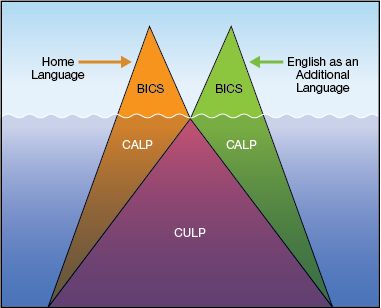Understanding the Acquisition of English as an Additional Language
Using Iceberg Models to Explain English Language Learner ProfilesEnglish language learners should be encouraged to maintain and develop their home languagehome language: the dominant language that a student uses at home to communicate with family members as their English proficiency develops. This helps to build and cultivate a strong common language base, boosting the development of both languages. When conditions are optimal, it is possible for a student to become fully proficient in both languages (bilingual), as represented by the following model.  In this model, both sides of the iceberg are roughly equal and fully developed. CULP CULP (common underlying language proficiency) the language knowledge and skills that students develop as they learn one language that they can then use to help them learn other languages is fully developed and balanced, supporting both languages more or less equally. On each side of this iceberg model, CALPCALP (cognitive academic language proficiency): language required to understand and communicate about abstract concepts and accomplish a wide-range of cognitively demanding academic tasks, including reading textbooks, writing essays, and doing research exceeds BICSBICS (basic interpersonal communicative skills): simple, functional language for communicating basic needs, ideas, and opinions and engaging in everyday conversations in informal social situations in size, which is typical of a student who has acquired academic language proficiency in both languages. This model describes an adult individual who is bilingual (i.e., proficient in two languages). Individuals with less proficiency in a language would tend to have less well-developed CALP. For students beginning to learn a language, BICS would exceed CALP in size. The size and shape of each side of the iceberg would look different for different language learners, depending on their circumstances and level of proficiency in each language. The iceberg models for the following four scenarios are examples of common student profiles that illustrate the relationship between the student’s home language and English. The models also illustrate the development of social (BICS) and academic (CALP) language and the role of CULP in supporting the language development of English language learners. |

